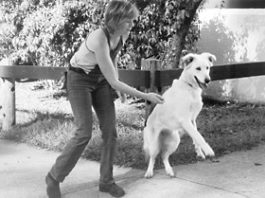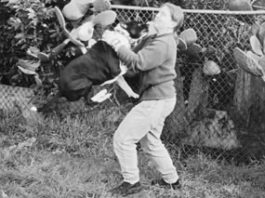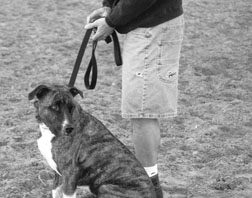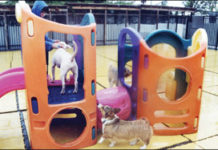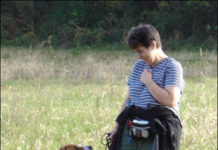How to Safely Break Up a Dog Fight
If you've ever been present when a dogfight broke out, you know how dangerous it can be for everyone concerned. I've lost track of how many times we've said this, but as always, prevention beats cure. It is imperative that you manage and train your own canine family to minimize the risk of serious dogfights. Identify situations that are likely to light the dogfight fuse, such as fence-fighting or resource guarding, and figure out how to avoid them and/or modify the behavior that causes them.
Doggie Daycare Can Be a Wonderful Experience: But is it For Every Dog?
The term "doggie daycare" has become a panacea in recent years for all manner of canine behavioral ills. Does your dog engage in destructive chewing? Nuisance barking? Rude greetings? Poor canine social skills? Mouthing and biting? Separation anxiety? Just send him to doggie daycare, and all will be well. You hope. I'll admit I'm as guilty as the next trainer of suggesting a daycare solution for a huge percentage of my behavior consult clients. The fact is, many of today's canine companions suffer from a significant lack of exercise, stimulation, and social time with their own kind. A good daycare provider can go a long way toward meeting those needs.
Modifying Aggressive Dog Behavior
That loud buzz you hear is the sound of the dog behavior and training community discussing a controversial new approach to modifying aggressive behavior in dogs. The developers of "Constructional Aggression Treatment" (CAT) claim that the shaping-based operant protocol produces stronger and much faster results than the classical counter-conditioning process widely used by training and behavior professionals today. CAT was devised and tested by Dr. Jes¨²s Rosales-Ruiz, a behavior analyst and associate professor of behavior analysis at the University of North Texas, and Kellie Snider, a board-certified associate behavior analyst. Snider completed her MS in Behavior Analysis at UNT in 2007 with Dr. Rosales-Ruiz as her graduate research advisor and the CAT procedure as the topic of her thesis research. Canine behavior experts frequently use classical conditioning techniques (including counter-conditioning) to help change how dogs feel about and respond to the stimuli that triggers their aggressive behavior. In other words, classical counter-conditioning changes the dog's emotions in order to change his behavior. In contrast, CAT utilizes "operant conditioning," where the goal is changing the dog's behavior in a way that will likely produce a subsequent emotional change.
Managing Dog-Aggressive Dogs in the Family
If you do nothing else about the aggression between your dogs, you must scrupulously manage their movements and activities. Every time your dog successfully engages in a behavior that you don't want her to exhibit, it makes it that much harder to convince her that it's not a useful behavior strategy. Every time your dog aggressively communicates to another canine family member, it increases the potential for unresolvable aggression between the two and serious injury to one or both.
Training Classes for Aggressive Dogs
dog owners are taught to recognize behavioral signs of impending aggression
Avoiding Potential Dog Attacks
There are many reasons a person might tend to look the other way when confronted with a potentially dangerous dog. You may be busy; you may be fearful of the dog's owner or potential retaliation; you may be friends with the owner and reluctant to cause hard feelings between you; you may worry about being responsible for the dog's impoundment and possible euthanasia; or you may simply feel that it's none of your business.
Living with a Difficult Dog
By your own standards, your dog’s life may not seem all that stressful – after all, he doesn’t have bills to pay, does he? But when you apply the more scientific definition of the word – anything that alarms or excites him, triggering his sympathetic nervous system into action and flooding him with the “fight or flight” chemicals adrenaline and noradrenaline – you may be able to see how many seemingly unrelated things in his environment actually contribute to his “misbehavior.”
Understanding Aggression in Dogs
Aggression. It's a natural, normal dog behavior, but it's also a scary word that evokes images of maulings and dog-related fatalities. The term aggression" actually encompasses a long continuum of behaviors
Dog Breed Stereotypes: Inaccurate and Damaging
Poor agreement was found between visual breed assignments and DNA results in 14 of the 20 dogs (70 percent). Moreover, there was low inter-rater reliability, meaning that the dog experts did not show a high level of agreement regarding breed assignments to the 20 dogs. More than half of the evaluators agreed on the predominant breed in only seven of the 20 dogs (35 percent). These results provide evidence that physical appearance is not a reliable method for breed identification.
Constructional Aggression Treatment (CAT) Can Improve Behavior
Aggressive behavior in their beloved companions is an incredibly challenging and upsetting problem for most dog owners to deal with. The problem is painfully public -and the public is equally free with accusations and advice for the hapless owner of a reactive dog. Many training solutions" that people try are inhumane
Peacekeeping Among Cats and Dogs
It's fairly common for dogs to be placed for adoption with a caveat that there should be no cats
Could My Dog Be Racist?
Almost as soon as I walked into Boomer's house I could tell his owner was nervous. This isn't all that unusual when meeting a new client for the first time. I always have my new clients put the dog in another room so we can get acquainted with each other and have some time to chat without being distracted. Very often, the clients are uneasy during these initial consultations; I've grown accustomed to it. After all, often they have agonized over acknowledging their dog's issues and their decision to call in a professional. But after a few minutes, I could tell there was something more. I'd been called to help her dog with his reactive behavior. She related that he lunged and barked at some people as they walked by. During our discussion, she seemed unusually pensive and was having difficulty making eye contact with me. So I pressed, Is there anything else you need to tell me? Whatever it is




